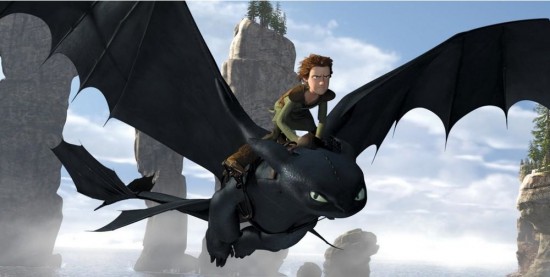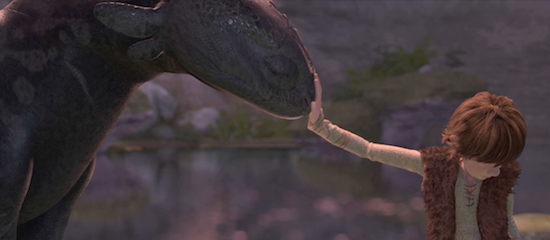Five Reasons Why You Should Go See How To Train Your Dragon THIS WEEKEND
Posted on Thursday, March 25th, 2010 by
David Chen

I’ll be the first to admit that when I
first saw the character art for Dreamworks Animation film
How to Train Your Dragon, I was unimpressed. “Here we go again,” I thought. “Another bland assortment of well-worn archetypes in another uninspired, crappy-looking Dreamworks picture.” But as
the positive buzz started pouring in, my anticipation for the film rose accordingly. And when I finally got a chance to see the film in a 3D IMAX presentation last weekend, I was completely blown away.
If you’re a fan of adventure films with a heart,
How to Train Your Dragon is a must-see. But, it’s also important for you to see the film
this weekend (and if at all possible, in 3D or IMAX 3D). Hit the jump to hear my reasons why.
 1. The Use of 3D is Incredible
1. The Use of 3D is Incredible - No film I’ve ever seen has more successfully recreated the sensation of flying as thrillingly or as beautifully as
How to Train Your Dragon. I would dare argue that the use of 3D in the flying sequences is more exhilarating than any of the ikran/dragon/flying sequences in
Avatar. Much of this has to do with the way the scenes were “shot,” often employing a 3rd-person perspective and depicting objects moving past the viewer so quickly that the sensation of speed is palpable. But the use of environment cannot be understated either; the backgrounds and scenic vistas are rendered vividly, and there are sequences in this film so
beautiful that they brought tears to my eyes.
See this film in 3D, and IMAX 3D if possible. If you think of 3D as merely a gimmick that can’t create a more immersive theatergoing experience,
How to Train Your Dragon will change your mind.
2. John Powell’s Amazing Score - I’ve
always been a fan of composer John Powell’s
music
, from the atmospheric work in the
Bourne films and
Green Zone to the soaring themes of
Bolt and
Kung Fu Panda. But Powell really outdoes himself with the score for
How to Train Your Dragon. In my opinion, this has already cemented itself as one of the best film scores of 2010, not to mention one of the best scores of the past several years. James Horner’s
Avatar score
wishes it could be this score’s *****, but they’re not even in the same league.
I wish I could share the music of this film with everyone I know, but instead, a few brief clips will have to suffice. Here’s what I call the “hero theme” (from the track “Test Drive”), which rousingly captures the excitement of manned flight.
And here’s what I would refer to as the “love theme” (from the track “Romantic Flight”) used to depict the relationship between Astrid and Hiccup.
You can buy the score on
Amazon or on
iTunes and I’d highly recommend it. It is one of those rare scores that serves as a great companion to the film and holds up as its own musical creation.
3. Jay Baruchel - This time around, it looks like the directors have avoided Dreamworks’ nasty habit of
stunt casting and instead chosen actors that are perfect for their roles. Jay Baruchel has perhaps had one of the most improbable Hollywood careers that I can think of, but I continue to cheer him on in his success. Here, Baruchel plays our protagonist Hiccup, who longs for the approval of his peers and his Viking father (
Gerard Butler
), yet is far better with his blacksmith’s tools than with dragon-slaying weapons. Hiccup spends much of the film flustered and frustrated. But with a voice that is both geeky and vulnerable, Hiccup ultimately winds up attracting our sympathy and love. Baruchel is also responsible for some great comedic timing and some pretty memorable laughs.
I realize that the films of Dreamworks Animation have featured a diverse array of directors and writers, but to me, their most well-known efforts (e.g.
Shark Tale,
Shrek,
Madagascar, and
Kung Fu Panda) are bound together by the common theme of accepting yourself for who you are. In this context,
How to Train Your Dragon is the logical culmination of that theme, and Baruchel’s squeaky-voiced performance as Hiccup juxtaposed with Butler’s thick Viking/Scottish brogue perfectly capture the dichotomy between brawn and brains (and why the latter might be preferable).
 4. Toothless -
4. Toothless - Ultimately,
How to Train Your Dragon is a simple story about a boy and his dog, only the dog is played by a massive black dragon named Toothless. Unlike the creatures in other Dreamworks Animation films, Toothless doesn’t speak or crack wise, make pop-culture references, or dance to songs by Smashmouth; instead, directors
Chris Sanders and
Dean DeBlois have to rely on
body language, grunts, and eye movements to communicate all of Toothless’s emotions. And just as they did in
Lilo and Stitch, they’ve created a memorable, adorable creature who will win the hearts of children and families everywhere.
5. The Competition for 3D Screens is Fierce - Numbers 1-4 above are just generally good reasons to see the film, so why is it important to check it out
this weekend? Why not wait until next week when you’ll have time to bring the whole family? Quite simply, there may not be enough 3D screens to support
How to Train Your Dragon for the long haul, and having seen both 3D and 2D versions,
I believe that seeing this film in 3D is absolutely the optimal way to view it.
The U.S. has 39,380 theater screens and right now less than 3,500 of them are equipped to play 3D films.
Dragon is being beset on all sides (and weekends) by other 3D films;
Avatar is still out in theaters,
Alice in Wonderland is doing gangbusters at the box office, and next week it looks like studios may be placing their bets with Leterrier’s
Clash of the Titans. That means that
Dragon may only have one week to a) Play on a preponderance of 3D screens, and b) Prove that it has staying power.
In all,
Dragon will be playing in 4,055 theaters, and 2,178 of them will have 3D capabilities, including 185 IMAX locations. However,
Alice will continue to play in 3,384 locations, including 1,450 3D screens. While this gives
Dragon more screens than
Monsters vs. Aliens had, it’s still a suboptimal outcome and is leading to
middling predictions for the film’s box office this weekend.
This is particularly dismaying to me, because I think
Dragon is a far superior film to Burton’s
Alice, not to mention /Film editor-in-chief Peter Sciretta has already written about
the crappiness of Clash’s 3D upconversion. Thus,
Dragon might be slayed by two less deserving films, and that saddens me greatly.
Interestingly, Dreamworks is the studio of Jeffrey Katzenberg,
one of the champions of 3D technology who was most likely instrumental in getting this many 3D screens up and running in the first place. That his own film may suffer severely due to a glut of 3D films at the box office is perhaps the greatest irony of
Dragon’s release.





